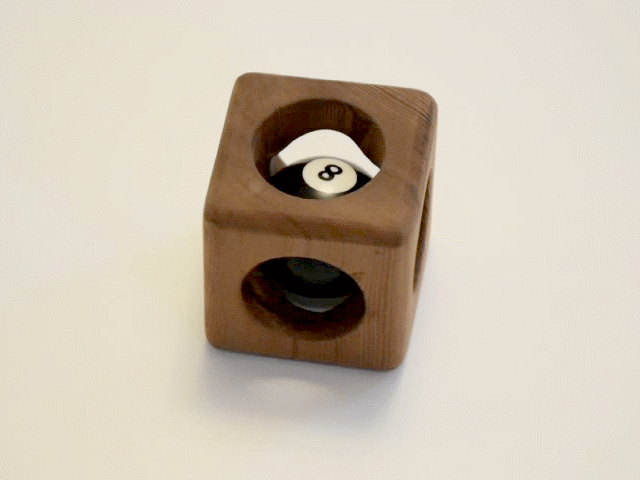8-Ball in Solid Wood Cube
by tomatoskins in Workshop > Woodworking
172505 Views, 921 Favorites, 0 Comments
8-Ball in Solid Wood Cube



There is something magical about wood puzzles. This mystery leaves the mind searching for any rationalization, any form of understanding that will answer the question of "How did that happen?" In this instructable, I will show you how to put an 8-ball into a block of wood so you can leave others searching for an answer themselves.
Parts



You will need:
- 8-Ball
- Scrap Wood (I used a 4x4 made of cedar)
- 1-7/8-inch Forstner Bit or Hole Saw
- Wood finish
Joint and Plane 4x4



Using a joiner and planer, take the overall size of the 4x4 down to 3" x 3" and cut into a 3" x 3" x 3" cube.
Mark the Center of the Cube

Using a straight edge, mark the center of the cube so you know where to drill the holes.
Router Edges


Using a 1/4" roundover bit, router the cube starting with the end grain using a push block to prevent tear out.
Drill Holes





Using a 1-7/8" hole saw or forstner bit, drill out the center. Drill one side of the end grain then the other. Slowly work your way around the cube removing the wood plugs as you go.
Sand Cube

Using sandpaper, smooth the cube and remove all sharp edges from the drilled holes. This will help later when the 8-ball is placed inside the cube.
Soak and Boil the Cube



Using enough water to cover the cube, soak it for at least 24 hours. I soaked this cube for 36 hours just to be safe. After soaking, boil it for an hour to ensure proper saturation. Since wood floats, place something on top of the cube to hold it underwater. I used a glass vase I had nearby.
Lubricate the 8-Ball

I covered the 8-ball with paste wax to act as lubricant for the next step.
Press 8-Ball in Place




After the cube is finished boiling, use a bench vise to press the 8-ball inside the cube through the end grain. Do this slowly to prevent the wood from cracking. If you push cross grain you will split your cube. I used a cut off piece of PVC to press against the 8-ball to protect it from the vice.
-------SCIENCE-------
The reason this step works, is because of how trees are formed. Pretend that the bundle of matches in the photos above are the straw-like fibers of a tree (xylem). When the fibers of the wood get heated and saturated with water, they become flexible and stretchy. This allows you press the ball through the end grain of the wood. If you try to press the ball through the side grain, the wood doesn't move as easily, and in our project you risk possibly breaking the cube.
Final Sanding


The cube will no longer be smooth because it soaked in water for so long. Once the cube dries overnight, sand it smooth. Be sure to sand the inside of the cube as well. I found the best method was to do it by hand to prevent scratching the 8-ball.
Apply Finish

I finished my cube with a beeswax oil mixture found online. Apply liberally with a rag. I used this finish for two reasons. If there was still water inside the wood I didn't want to trap it there and risk the finish bubbling, and I didn't want any finish to change the look and smoothness of the 8-ball.
How to Remove the 8-Ball


Other than potentially boiling the cube and 8-ball again and repeating the process done before, the only way to get the ball out is to break the cube around it. Using a chisel, this test cube was no match and the 8-ball was easily removed.